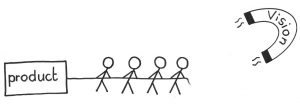Alignment lies in the process of linking the strategic objectives of the organization with the objectives of each individual in the organization. It requires a close link between planning, execution and their constant synchronization. This dimension implies ensuring the alignment and linking of strategic objectives, both vertically and horizontally, promoting progress and actions at all organizational levels.

Alignment isn’t about what numbers to hit, it’s about creating clarity of which mountain to climb.

The agile product management practice represents a tool that can maintain an aligned environment, from the general strategy of the company, through its tactics and in turn in this step the creation of the product vision, of each strategic initiative, its framework of extended product vision and the relevant business model, to test the main hypotheses of the initiative, to later develop the road maps, showing the windows of opportunity and thus work directly with the teams so that they define the as aligned to these artifacts.
Proper governance still ensures alignment, but is guided by flexibility and empowerment rather than rigid enforcement. Do teams understand their own “sense of purpose”? It is a question that needs to be asked.

A powerful practice that can be carried out in the work environment specifically for a team or set of teams, is the realization of “team vision workshops”, which consist of contrasting the product vision that the business owner is looking for with a initiative in particular, think about the purpose and meaning, the product vision, so the product owner discusses these elements and the business model with the team in question, in addition to defining what value means for the business, after This exhibition is made in a 1-2-4-all structure, in this way the team or teams can co-create the team vision, the purpose and the meaning necessary for the effective construction of the product, exposing the key capabilities for it. , in this approach the team may find that there are certain resources or skills / abilities missing in the team, as well as risks that need to be addressed to accelerate the construction of the team. However, the product owner discusses these elements and commits to the team, to consider them, this increases the commitment and empowerment of the team, which in the long run leads to an increase in ownership or ownership of the same, it is a forceful practice to align the scheme, as it requires a commitment of the highest level, through the commitment established by the team and the facilitation of the product owner.

Senior executives must make strategy their number one priority, and they can pull the levers to drive transformational change. At deeper levels, such levers are not available, so it is advisable to focus on the team’s sense of purpose, what they want to achieve over the next period, and then work to link this with the strategic goals, the practice of managing product is very effective at it.
One suggestion is to discuss together the organization’s sense of purpose, as summarized in the mission, how the team relates to other parts of the organization, as well as the individual’s own sense of purpose: what they want to achieve in the short term. medium term and when, why, and how.

Think about the cadence of inspection and adaptation cycles that allow decision-making based on data and results, of what works and what does not, in such a way that the strategy team is constantly in session to accelerate the evolution cycles of the company based on market triggers for the benefit of customers.
Responsiveness, being receptive implies adaptation and continuous realignment with the changing environment.
Responsibility requires team ownership, synchronizing the team’s progress, any indicator, whether anticipatory or lagging, should be followed by real-time discussions along with the refinement of the plans and actions of those involved.
Miguel Ángel Martínez Hernández, March 15th, 2021.
References:
- Ismail, I., Palao, F., y Michelle, L. (2019). Transformación Exponencial. México D.F.: Bubok Publishing SL.
- Lyngso, S. (2014). Agile strategy management: Techniques for continuous alignment and improvement. Boca Raton: CRC Press.
- Fernando, R. (2019). Agile strategy: How to create a strategy ready for anything. Harlow, England: Pearson.
- Lambert, D. (2020). Practical Guide to Agile Strategy Execution: Design, Architect, Prioritize, and Deliver your Corporate Future Successfully. CA: Independently published.
- Pichler, R (2016). Strategize: Product Strategy and Product Roadmap Practices for the Digital Age. Wendover, UK: Pichler Consulting.
- Wiraeus, D., y Creelman, J. (2019). Agile strategy management in the digital age: How dynamic balanced scorecards transform decision making, speed and effectiveness. Cham, Switzerland: Palgrave Macmillan.
- Porter, D. T., y Porter, M. E. (2015). Estrategia competitiva: Técnicas para el análisis de los sectores industriales y de la competencia. México D.F.: Grupo Editorial Patria.
